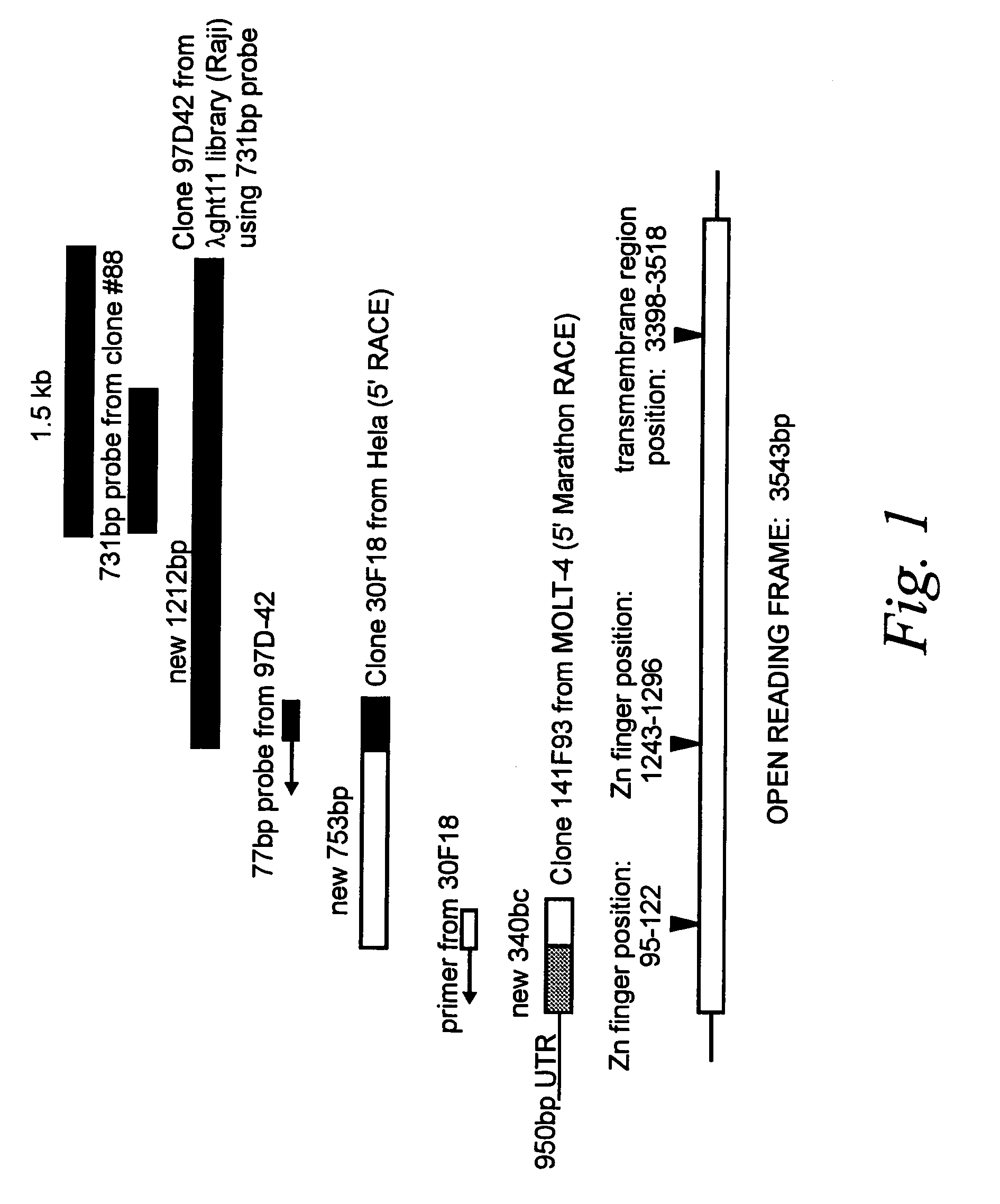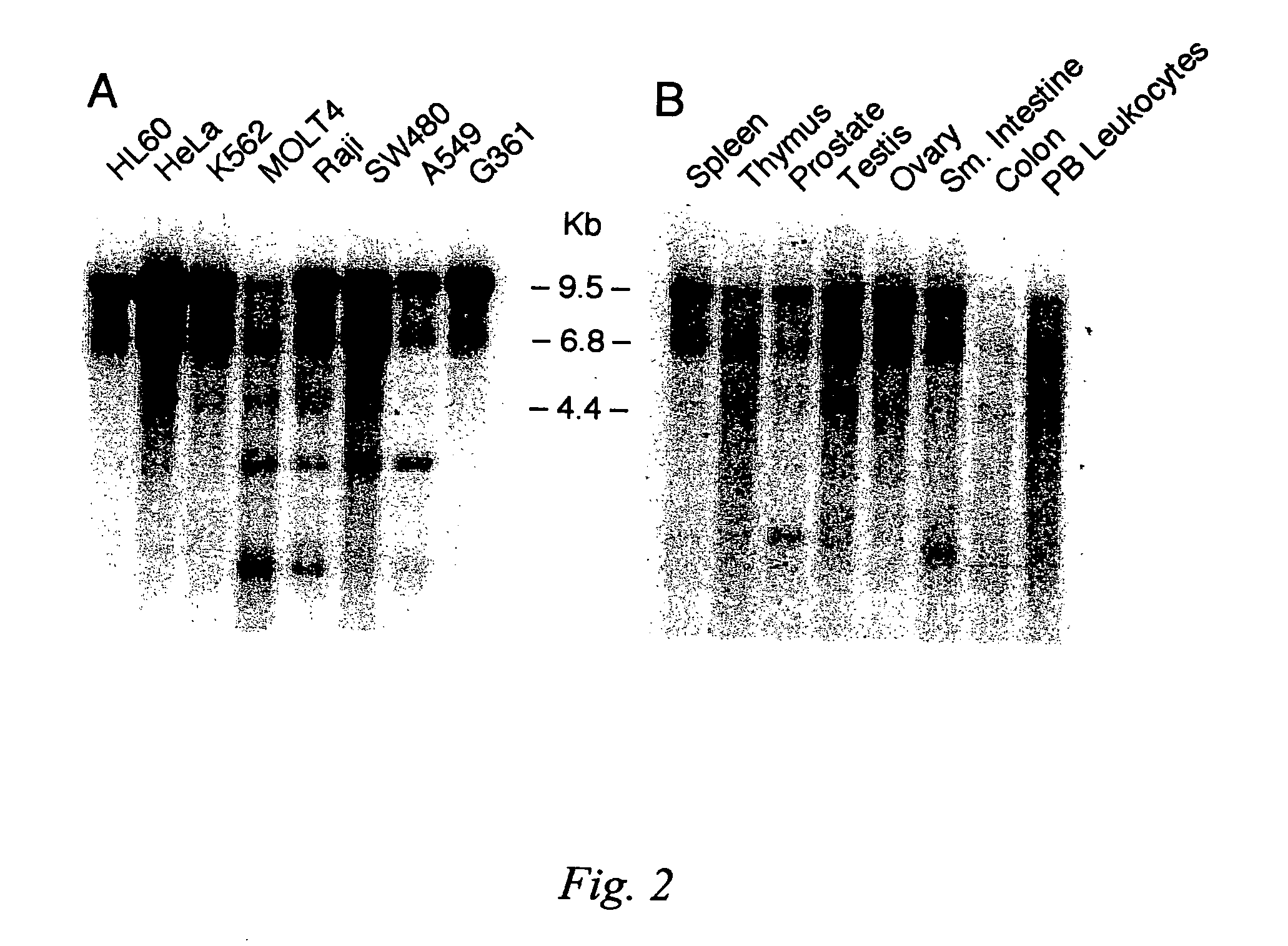Mammalian cell surface DNA receptor
a dna receptor and mammalian cell surface technology, applied in the direction of antibodies, depsipeptides, peptide/protein ingredients, etc., can solve the problems of inconvenient use, inability to target selected tissue, and inability to specificize the process, so as to achieve similar fluorescence and increase fluorescence
- Summary
- Abstract
- Description
- Claims
- Application Information
AI Technical Summary
Benefits of technology
Problems solved by technology
Method used
Image
Examples
example 1
Isolation of a Human Membrane-Associated DNA Receptor (DNA-R)
[0084]As described in the specification above, DNA binding to cells had been observed in the art, and the behavior of said binding suggested the existence of a DNA binding protein expressed at the cell surface. In order to isolate a novel DNA-binding protein from human cells, serum from a patient with systemic lupus erythematosus (SLE), treated to deplete the sera of anti-DNA antibodies by multiple (6×) passages over a DNA sepharose column, was used to screen a λgt11 cDNA expression library made from liposaccharide stimulated human monocytes. This serum has been shown to have anti-DNA receptor activities (defined by the blocking of DNA binding to cells; Bennet et al., 1992. J. Clin. Invest. 76: 2182–2190).
[0085]From approximately one million plaques screened with this sera, ten positive phage clones were identified and isolated according to the technique of Young and Davis (1983, Proc. Natl. Acad. Sci. USA 80: 1194–1198). ...
example 2
DNA Receptor Gene Expression and Protein Sequence Analysis
[0089]Tissue-specific and cell line-specific expression patterns of its corresponding mRNA in various human tissues was analyzed by Northern blot analysis on RNA isolated from various tissues and cancer cell lines. The results of these experiments are shown in FIG. 2.
[0090]A panel of tissue samples was examined by Northern hybridization analysis performed under low stringency conditions, defined as hybridization at 42° C. in 5× SSPE (0.75M NaCl, 0.05 mM NaH2PO4, 5 mM EDTA), 10× Denhardt's solution (0.2% Ficoll, 0.2% polyvinylpyrrolidone, 0.2% bovine serum albumen), 100 μg / mL salmon sperm DNA, 2% SDS and 50% deionized formamide and 1–2×106 cpm random-primed, 32P labeled probe, followed by washing in 0.1×SSC (15 mM NaCl, 1.5 mM trisodium citrate, 0.1% SDS). The blots were hybridized with aprobe consisting of 442 bp of sequence from the 3′ end of the coding sequence from the DNA-R gene to determine the distribution of receptor m...
example 3
DNA Receptor Expression and Protein Expression Analyses
[0093]The DNA-R of the invention was produced recombinantly as follows. A BamHI-HpaI cDNA fragment containing the coding sequence for amino acids 1–1190 (i.e., missing the two most carboxylterminal amino acids) of the DNA-R of the invention was cloned into pTriplFlu (obtained from J. Epstein, University of Pennsylvania, Philadelphia, Pa.). This vector contains a sequence encoding an epitope tag from the influenza hemagglutinin gene in triplicate inserted immediately 3′ of the multiple cloning site of the parent vector, pcDNA3, and which are in-frame with the inserted DNA-R cDNA sequence. This vector was introduced into human 293 cells by transfection using Lipofectamine (Life Technologies, Gaithersburg, Md.) according to the manufacturer's instructions. Transfected cells (293-DNA-R / flu) were selected by culturing in growth media (DMEM supplemented with 10% fetal calf serum, 2 mM L-glutamine, 100 U / mL penicillin and 100 g / mL stre...
PUM
 Login to View More
Login to View More Abstract
Description
Claims
Application Information
 Login to View More
Login to View More - R&D
- Intellectual Property
- Life Sciences
- Materials
- Tech Scout
- Unparalleled Data Quality
- Higher Quality Content
- 60% Fewer Hallucinations
Browse by: Latest US Patents, China's latest patents, Technical Efficacy Thesaurus, Application Domain, Technology Topic, Popular Technical Reports.
© 2025 PatSnap. All rights reserved.Legal|Privacy policy|Modern Slavery Act Transparency Statement|Sitemap|About US| Contact US: help@patsnap.com



